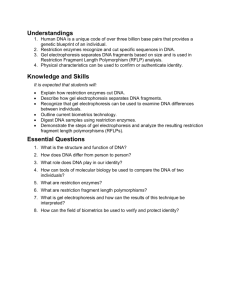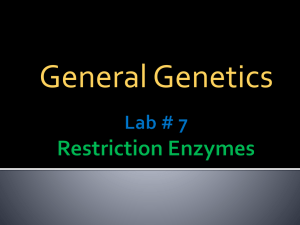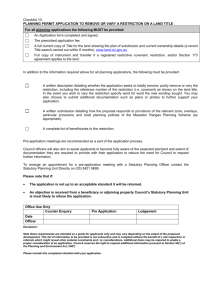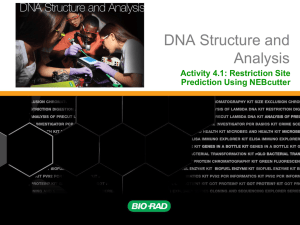A1.3.1.StudentResponse
advertisement
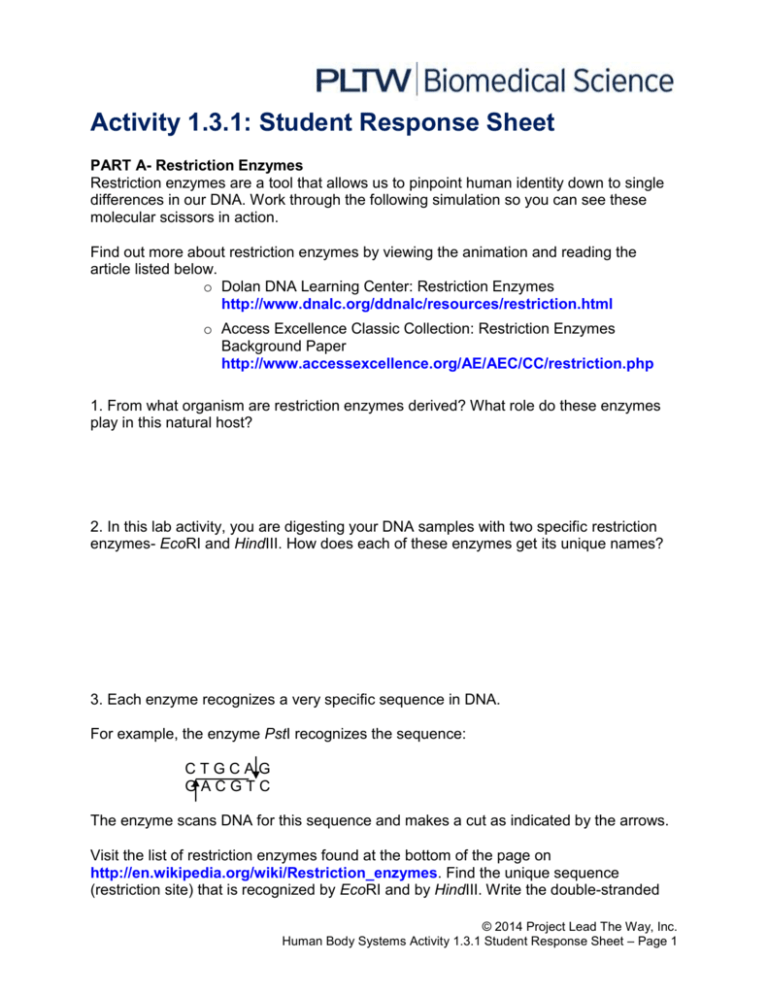
Activity 1.3.1: Student Response Sheet PART A- Restriction Enzymes Restriction enzymes are a tool that allows us to pinpoint human identity down to single differences in our DNA. Work through the following simulation so you can see these molecular scissors in action. Find out more about restriction enzymes by viewing the animation and reading the article listed below. o Dolan DNA Learning Center: Restriction Enzymes http://www.dnalc.org/ddnalc/resources/restriction.html o Access Excellence Classic Collection: Restriction Enzymes Background Paper http://www.accessexcellence.org/AE/AEC/CC/restriction.php 1. From what organism are restriction enzymes derived? What role do these enzymes play in this natural host? 2. In this lab activity, you are digesting your DNA samples with two specific restriction enzymes- EcoRI and HindIII. How does each of these enzymes get its unique names? 3. Each enzyme recognizes a very specific sequence in DNA. For example, the enzyme PstI recognizes the sequence: CTGCAG GACGTC The enzyme scans DNA for this sequence and makes a cut as indicated by the arrows. Visit the list of restriction enzymes found at the bottom of the page on http://en.wikipedia.org/wiki/Restriction_enzymes. Find the unique sequence (restriction site) that is recognized by EcoRI and by HindIII. Write the double-stranded © 2014 Project Lead The Way, Inc. Human Body Systems Activity 1.3.1 Student Response Sheet – Page 1 sequence below and draw an arrow between the base pairs to indicate where the enzyme would make its cut. EcoRI: HindIII: 4. What do you notice about each restriction site? What does the word palindrome mean? 5. Using the information above, digest the DNA samples for Person 1 and Person 2 using EcoRI. Scan the strand for the restriction site and draw an arrow any place this enzyme would make a cut. Beneath each strand indicate the number of fragments that would be created and also the size of each fragment (in base pairs). Some of the pieces will have bases overhanging the edge. Use only the bases that are paired up when completing your count. For example, for a piece that looks like ATTCAACCC GTTGGGAA the size of the fragment would be listed as 6 base pairs (6bp). Person 1: GGAATTAAGCTTATTGAATTCTTATAGAATTCGGGGCCCAAGCTTATGAATTCAATT CCTTAATTCGAATAACTTAAGAATATCTTAAGCCCCGGGTTCGAATACTTAAGTTAA Number of restriction fragments (pieces of DNA after digestion): _________ Size of restriction fragments (in bp) - listed from largest to smallest ______________________________________________________________________ © 2014 Project Lead The Way, Inc. Human Body Systems Activity 1.3.1 Student Response Sheet – Page 2 Person 2: CCATATAGAATTCAAGCTTAAGAATTCGGGGGAACGTTGAATTCAATTAATTGGG GGTATATCTTAAGTTCGAATTCTTAAGCCCCCTTGCAACTTAAGTTAATTAACCC Number of restriction fragments (pieces of DNA after digestion): _________ Size of restriction fragments (in bp) - listed from largest to smallest ______________________________________________________________________ PART B: Gel Electrophoresis of Restriction Fragments After you have reviewed the principles of electrophoresis, use what you know to complete the following: 1. “Run” your restriction fragments from both Person 1 and Person 2 on the gel drawn below. Use the DNA marker lane to help you draw in the bands you would see in each lane of the gel. 2. Place a large “+” on the end of the gel diagram where the positive electrode would go. Place a large “-“ on the end of the gel diagram where the negative electrode would go. Using what you know about the structure of DNA, explain why this placement is crucial to separating the fragments. © 2014 Project Lead The Way, Inc. Human Body Systems Activity 1.3.1 Student Response Sheet – Page 3 3. Use an asterisk (*) to indicate the smallest fragment shown on the gel. 4. Compare the DNA fingerprint of Person 1 and Person 2. Explain how this fingerprint would have looked different if you had digested the DNA of each person with HindIII instead of EcoRI. Think about these principles as you analyze your actual gel results from the missing person experiment. Remember that in the actual lab you digested each sample with two different restriction enzymes in separate reactions. © 2014 Project Lead The Way, Inc. Human Body Systems Activity 1.3.1 Student Response Sheet – Page 4
